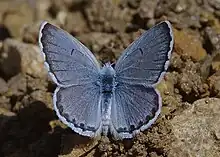Pseudophilotes vicrama
Pseudophilotes vicrama, the eastern baton blue,[1] is a small butterfly found in Asia,[2][3] east to Tian Shan and parts of China, west to the Balkans, Turkey, eastern Europe to southern Finland. It belongs to the lycaenids or blues family. The species was first described by Frederic Moore in 1865.
| Eastern baton blue | |
|---|---|
 | |
| In Turkey | |
_Macedonia.jpg.webp) | |
| In North Macedonia | |
| Scientific classification | |
| Domain: | Eukaryota |
| Kingdom: | Animalia |
| Phylum: | Arthropoda |
| Class: | Insecta |
| Order: | Lepidoptera |
| Family: | Lycaenidae |
| Genus: | Pseudophilotes |
| Species: | P. vicrama |
| Binomial name | |
| Pseudophilotes vicrama (Moore, 1865) | |
| Synonyms | |
| |
Taxonomy
This butterfly was earlier known as Polyommatus vicrama (Staudinger).[2]
Range
In Asia, it is found in South Asia from India (Himachal Pradesh) westwards to Balochistan and Chitral in Pakistan.[2]
Mark Alexander Wynter-Blyth records the eastern baton blue as not rare locally and occurring in Baluchistan and from Chitral to Shipki La.[4]
As per Savela, the butterfly is found in the Pamirs - Alay Mountains, Ghissar - Darvaz, Tian-Shan, north-west India south-eastEurope, Asia Minor, Caucasus, Transcaucasia, western Siberia, Altai, Turan and Kopet-Dagh.[3]
Description
The eastern baton blue is 20 to 26 mm in size. The male butterfly is pale dusky blue with a broad border, while the female is brown. The butterfly is named for its prominent chequered fringe.[4] In Seitz, it is described as a form of Baton — In Anterior Asia, the males have a brighter colour, which has often a silvery white sheen; this is clara Christ. — vicrama from Afghanistan, has no distinct discocellular spot on the upperside of the forewing, there being also no dark marginal dots on the hindwing above. — cashmirensis Moore, form Kashmir, has a distinct black discocellular spot on the forewing like the European forms on the upperside, moreover, the forewing bears whitish marginal lunules and dark veins and the hindwing marginal dots.[5]
Subspecies
- P. v. vicrama (Pamirs-Alai, Ghissar-Darvaz, Tian-Shan, north-western India)
- P. v. cashmirensis (Moore, 1874) Northeast Kashmir
- P. v. astabene (Hemming, 1932) (Kopet-Dagh)
- P. v. clara (Christoph, 1887) (The Balkans, Middle East, United Arab Emirates, Oman, Turkestan)
- P. v. pallida (Shchetkin, 1960) (Turan, southern Ghissar)
- P. v. schiffermulleri (Hemming, 1929) (south-eastern Europe, Asia Minor, Caucasus, Transcaucasia, western Siberia, Altai)
Cited references
- Beccaloni, G.; Scoble, M.; Kitching, I.; Simonsen, T.; Robinson, G.; Pitkin, B.; Hine, A.; Lyal, C., eds. (2003). "Pseudophilotes baton ssp. vicrama". The Global Lepidoptera Names Index. Natural History Museum. Retrieved April 23, 2018.
- Evans, W.H. (1932). The Identification of Indian Butterflies (2nd ed.). Mumbai, India: Bombay Natural History Society. p. 225, ser no H22.2.
- Savela, Markku, ed. (December 21, 2018). "Pseudophilotes vicrama (Moore, 1865)". Lepidoptera and Some Other Life Forms. Retrieved January 14, 2021.
- Wynter-Blyth, Mark Alexander (1957). Butterflies of the Indian Region. Bombay, India: Bombay Natural History Society. p. 281. ISBN 978-8170192329.
- Seitz, A. in Seitz, A. ed. Band 1: Abt. 1, Die Großschmetterlinge des palaearktischen Faunengebietes, Die palaearktischen Tagfalter, 1909, 379 Seiten, mit 89 kolorierten Tafeln (3470 Figuren)
 This article incorporates text from this source, which is in the public domain.
This article incorporates text from this source, which is in the public domain.
References
- Beccaloni, George; Scoble, Malcolm; Kitching, Ian; Simonsen, Thomas; Robinson, Gaden; Pitkin, Brian; Hine, Adrian; Lyal, Chris. "The Global Lepidoptera Names Index (LepIndex)". Natural History Museum, London. Retrieved 2016-10-15.
- Evans, W.H. (1932). The Identification of Indian Butterflies (2nd ed.). Mumbai, India: Bombay Natural History Society.
- Wynter-Blyth, Mark Alexander (1957). Butterflies of the Indian Region. Bombay, India: Bombay Natural History Society. ISBN 978-8170192329.